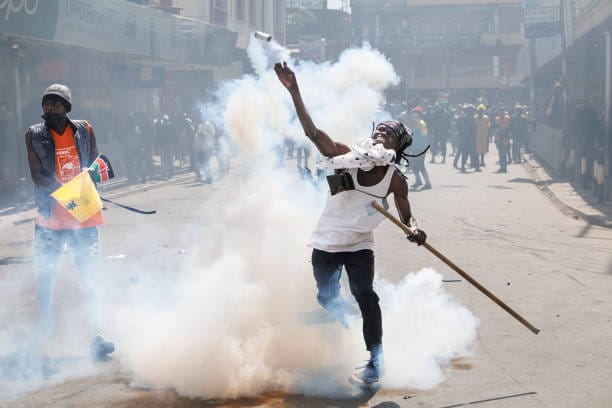In Summary
- Kenyan police fired tear gas to disperse anti-government protests in Nairobi and Mombasa.
- Protests began over a controversial finance bill and morphed into calls for President William Ruto to resign.
- Human rights groups report 39 people killed by security forces since protests began.
- Ruto dropped proposed tax increases but unrest continues over police brutality and economic issues.
- Businesses closed, clashes with police, shop owners hiring vigilantes to prevent looting, and court hearings postponed.
NAIROBI, KENYA– Kenyan police have fired tear gas in the capital, Nairobi, and the coastal city of Mombasa to disperse anti-government protests. Demonstrators also took to the streets in other cities, including Kisumu. In both city centers, many businesses remained closed, reflecting the widespread impact of the unrest.
Human rights groups report that since the protests against a controversial finance bill began two weeks ago, 39 people have been killed by security forces. Despite President William Ruto dropping the proposed tax increases, the demonstrations have evolved into calls for his resignation and anger over police brutality.
Scenes of chaos unfolded in Mombasa, where cars burned as protesters clashed with police. The clashes in Nairobi forced magistrates to postpone hearings at a city court, according to the Daily Nation newspaper. Shop-owners in central business areas of Nairobi and Mombasa hired vigilantes armed with clubs to guard against looting.
Astin Kibowen, 21, guarding the music shop where he works in Nairobi, told the BBC he wanted the president “to listen to our cries, to our voices.” Since President Ruto came to power two years ago, promising to revitalize the economy, Kenyans have faced a cost-of-living crisis with increased taxes on salaries, fuel, and gross sales.
The state-funded Kenya National Commission on Human Rights (KNCHR) stated that most protesters were killed last Tuesday when MPs voted to pass the bill. Seventeen people died in Nairobi, and 22 others were killed in other parts of the country. Additionally, there were 361 injuries, 32 cases of “enforced or involuntary disappearances,” and 627 arrests.
Amnesty International reported that 24 protesters died in the protests, while earlier police figures put the death toll at 19.
An artist in Nairobi, Linda Indakwa, 29, expressed her intention to capture the demonstrations through her art. “We are mourning the children killed by police. As others chant, I’m doing art,” she said, pointing to an artwork she set up in the city center.
The KNCHR condemned “in the strongest terms possible the unwarranted violence and force” inflicted on protesters, medical personnel, lawyers, journalists, and on safe spaces such as churches, medical emergency centers, and ambulances. They criticized the force used against the protesters as “excessive and disproportionate.”
President Ruto defended the police, stating they had “done their best they could” during a roundtable interview with journalists on Sunday. He added that “if there were any excesses,” they would be addressed through “existing mechanisms.”
https://www.africanexponent.com/kenyan-police-use-tear-gas-to-disperse-protests-in-nairobi-and-mombasa/


